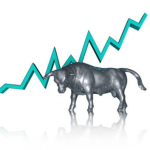 “Buy the dip” was the mantra of 2013, and the idea was simple and profitable: when stocks went down, buy more. In such a feverish bull market with many more up days than down days, profits were only limited to how much money you had to invest.
“Buy the dip” was the mantra of 2013, and the idea was simple and profitable: when stocks went down, buy more. In such a feverish bull market with many more up days than down days, profits were only limited to how much money you had to invest.
Of course, it’s important to know why “buy the dip” was so successful, and the answer that most people agreed on was simple: the Federal Reserve. In simple terms, the Federal Reserve was expanding the monetary base by buying bonds as part of its quantitative easing program. This money had to go somewhere, so of course it went into assets such as stocks, particularly at a time when the S&P 500 P/E ratio was relatively low.
At the same time, the Fed was also keeping interest rates very low. This benefited stocks as well for two reasons. Firstly, it made it cheaper for institutional investors to invest on margin, increasing aggregate demand amongst the pros for stocks. Secondly, it made Treasuries less appealing as an investment because the returns were far too low to yield a livable wage for retirees, while also keeping returns on high yield bonds low relative to the risk. So stocks became all the more appealing.
2014 is slated to be the year when the Fed’s latest bout of Quantitative Easing winds down and finally stops. Among the many predicted impacts of this will be relatively flat or declining stock prices—and this is part of the reason why investors sold off so radically in January; they wanted to get out before everyone else.
Then, in February, something very odd happened: people kept buying the dip.
Now everyone is struggling to understand why this is happening; is “buy the dip” still the vogue, and will it buoy stocks again in 2014? If so, what would drive the asset purchases if it isn’t QE?
Josh Brown, the infamous Reformed Broker, has a compelling theory: the dip buying is a result of a fundamental change in the way money is managed. The entire piece is worth reading, but the argument is simple: big money managers aren’t rewarded for trading as much as they are rewarded for a buy-and-hold strategy, and so they are continually buying stocks as they are given more and more money to manage.
If this is the case, the way to identify how stock prices will change becomes very simple: focus on capital flows. See who is getting money and where that money is being directed. This is also troubling, because it can easily cause an asset bubble where valuation and bad economic data is ignored in the rush to buy with newly managed funds.
